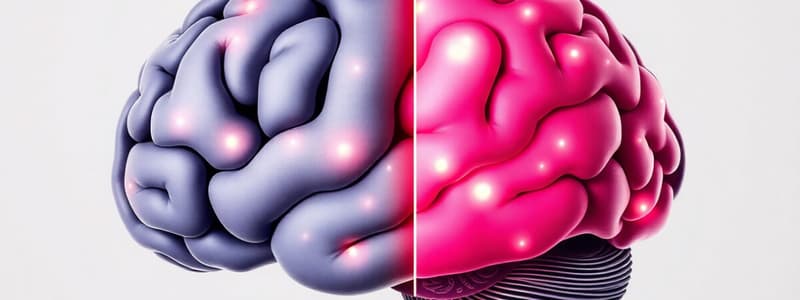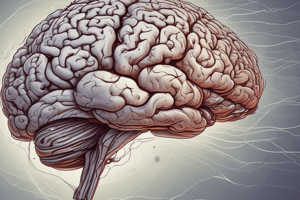Podcast
Questions and Answers
What is the primary role of dopamine in learning behaviors?
What is the primary role of dopamine in learning behaviors?
- It is associated with the feeling of liking a reinforcer. (correct)
- It helps in the formation of new neural connections.
- It regulates the extinction of learned responses.
- It controls the timing of reinforcement schedules.
Which reinforcement schedule is most effective when first learning a new behavior?
Which reinforcement schedule is most effective when first learning a new behavior?
- Variable ratio reinforcement schedule.
- Intermittent reinforcement schedule.
- Fixed interval reinforcement schedule.
- Continuous reinforcement schedule. (correct)
What is the purpose of negative reinforcement in handling undesirable behavior?
What is the purpose of negative reinforcement in handling undesirable behavior?
- To remove an aversive stimulus once a goal is achieved (correct)
- To introduce an aversive stimulus that remains in place
- To completely ignore undesirable behavior
- To punish students severely for their misbehavior
How does an intermittent reinforcement schedule maintain behavior?
How does an intermittent reinforcement schedule maintain behavior?
Which method involves practicing correct responses immediately after errors are made?
Which method involves practicing correct responses immediately after errors are made?
What are antecedents in the context of behavior change?
What are antecedents in the context of behavior change?
What is meant by 'stimulus control' in behavior modification?
What is meant by 'stimulus control' in behavior modification?
What is a caution related to the application of punishment?
What is a caution related to the application of punishment?
What is essentially the goal of a Functional Behavioral Assessment (FBA)?
What is essentially the goal of a Functional Behavioral Assessment (FBA)?
Which method is considered more effective for instruction delivery?
Which method is considered more effective for instruction delivery?
What is response cost in the context of handling undesirable behavior?
What is response cost in the context of handling undesirable behavior?
What is described as the disappearance of a learned response?
What is described as the disappearance of a learned response?
Which of the following types of reinforcement schedules is based on the number of responses between reinforcers?
Which of the following types of reinforcement schedules is based on the number of responses between reinforcers?
How should reprimands be delivered to be effective?
How should reprimands be delivered to be effective?
What should be the focus when applying punishment to students?
What should be the focus when applying punishment to students?
What general motivation do students exhibit when they act out, according to functional behavioral assessment principles?
What general motivation do students exhibit when they act out, according to functional behavioral assessment principles?
What is the primary focus of shaping in behavior modification?
What is the primary focus of shaping in behavior modification?
What is the purpose of task analysis in shaping?
What is the purpose of task analysis in shaping?
Which strategy should be used to encourage persistence after behaviors are established?
Which strategy should be used to encourage persistence after behaviors are established?
What is a contingency contract?
What is a contingency contract?
What is a token reinforcement system designed to do?
What is a token reinforcement system designed to do?
How can the Premack principle be applied in a classroom setting?
How can the Premack principle be applied in a classroom setting?
What is the main goal of group consequences in a classroom environment?
What is the main goal of group consequences in a classroom environment?
Which of the following is NOT a recommended practice in encouraging positive behaviors?
Which of the following is NOT a recommended practice in encouraging positive behaviors?
What is the main goal of positive behavior supports (PBS)?
What is the main goal of positive behavior supports (PBS)?
What is the purpose of precorrection in positive behavior supports?
What is the purpose of precorrection in positive behavior supports?
Which of the following is NOT a characteristic of self-management?
Which of the following is NOT a characteristic of self-management?
How can students reinforce their own behavior according to the self-management approach?
How can students reinforce their own behavior according to the self-management approach?
What role do families play in applying self-management strategies?
What role do families play in applying self-management strategies?
Which of the following components is included in the three-tier prevention and intervention approach of PBS?
Which of the following components is included in the three-tier prevention and intervention approach of PBS?
What is an essential part of monitoring and evaluating progress in self-management?
What is an essential part of monitoring and evaluating progress in self-management?
Which strategy should be avoided when introducing a self-management system to students?
Which strategy should be avoided when introducing a self-management system to students?
What distinguishes enactive learning from observational learning?
What distinguishes enactive learning from observational learning?
What does Bandura's social cognitive theory emphasize?
What does Bandura's social cognitive theory emphasize?
Which principle should teachers follow to promote positive behavior in their students?
Which principle should teachers follow to promote positive behavior in their students?
What is a potential criticism of using rewards in learning environments?
What is a potential criticism of using rewards in learning environments?
What is a key difference between learning and performance according to Bandura?
What is a key difference between learning and performance according to Bandura?
Why might praise be ineffective in a classroom setting?
Why might praise be ineffective in a classroom setting?
How do behavioral strategies benefit students according to the principles for teachers?
How do behavioral strategies benefit students according to the principles for teachers?
What is Bandura's view on the system of rewards in education?
What is Bandura's view on the system of rewards in education?
Flashcards are hidden until you start studying
Study Notes
### Brain & Learning
- Different parts of the brain are involved in learning, with the cerebellum involved in simple learning and other parts involved in learning to avoid painful stimuli.
- Brain chemicals, like dopamine and opiate-like substances, are involved in the “liking” of a reinforcer.
Reinforcement Schedules
- Continuous reinforcement schedule: A reinforcer is given after every desired response. This is effective for teaching new behaviors.
- Intermittent reinforcement schedule: A reinforcer is given after some desired responses. This is effective for maintaining behaviors.
- Interval schedule: Reinforcer based on time between reinforcement.
- Ratio schedule: Reinforcer based on number of responses between reinforcement.
### Antecedents and Behavior Change
- Antecedents: Events that come before a behavior.
- Stimulus control: The capacity for an antecedent to cause a behavior. This is also how teachers use cues:
- Effective Instruction Delivery: Clear, concise instructions that communicate the expected outcome are more effective than questions.
- Cueing: A stimulus that sets up the desired behavior.
Shaping
- Shaping (successive approximations) involves reinforcing each small step of progress towards a desired behavior.
- This is useful when the student cannot perform the entire task, but can perform part of it.
- It involves breaking a task into smaller steps and then reinforcing each step.
### Encouraging Positive Behaviors
- Quickly recognize and reinforce positive behaviors in ways that students value.
- Provide reinforcement on an unpredictable schedule after behaviors are established.
- Utilize the Premack principle to identify effective reinforcers.
- Use cueing to help establish new behaviors.
- Ensure that all students receive praise and rewards for doing something well.
Contingency Contracts, Token Reinforcement, and Group Consequences
- Contingency contracts: Written agreements between teacher and student outlining expectations and rewards.
- Token reinforcement systems: Students earn tokens for academic work and good behavior, which can be exchanged for rewards.
- Group consequences: Rewards or punishments given to the entire class for adhering to or violating rules.
### Handling Undesirable Behavior
- When problems persist, consider using:
- Negative reinforcement: Removing an aversive stimulus to encourage desired behavior.
- Positive practice overcorrection: Practicing the correct response immediately after an error.
- Reprimands: Criticisms for misbehavior. This should be done privately and quietly to be effective.
- Response cost: Punishment by removing rewards or privileges.
- Social isolation/time out: Briefly removing the disruptive student.
### Some Cautions About Punishment
- Punishment can have social, emotional, and motivational consequences.
- Studies have shown that punishment, especially physical punishment, is ineffective and harmful.
- When using punishment, focus on the behavior and what the student should do instead.
- Consider the following guidelines:
- Structure the situation to use negative reinforcement instead of punishment.
- Keep punishment mild and brief, and pair it with doing the right thing.
- Be consistent in applying punishment.
- Focus on the student’s actions, not their personal qualities.
- Adapt the punishment to the infraction and ignore minor misbehaviors.
### Functional Behavioral Assessment
- Aims to discover why a student acts out.
- Common reasons for acting out:
- To get attention, gain a desired item or activity, or sensory stimulation.
- To escape attention, escape a demanding or boring task, or escape painful or disturbing sensory stimulation.
- Data from FBA observations is used to identify and analyze the function of the behavior.
### Positive Behavior Supports
- Interventions designed to replace problem behaviors with new, appropriate behaviors.
- These interventions are based on the functional behavioral assessment.
- Precorrection: A preventive strategy used to identify the context for the student’s misbehavior, specify alternative expected behaviors, modify the situation to make the problem behavior unlikely, rehearse the expected positive behaviors, and reinforce them.
- PBS can be used successfully in school-wide programs.
- There are three tiers of prevention and intervention.
### Self-Management
- Students take responsibility for their own learning and behavior.
- Components:
- Goal setting: Students set specific goals and make them public.
- Monitoring and evaluating progress: Students monitor and evaluate their own progress toward goals.
- Self-reinforcement: Students control their own reinforcers by denying themselves a reward until a goal is met, then reinforcing themselves with the reward.
### Challenges and Criticisms
- Albert Bandura proposed social learning theory to explain learning through observation of others.
- He distinguishes between enactive and observational learning.
- He also distinguishes between learning and performance.
### Criticisms of Behavioral Methods
- There is debate about whether students should be rewarded for learning.
- Critics argue that rewards can control students and decrease their intrinsic motivation.
- Other perspectives argue that rewards can increase intrinsic motivation and confidence.
- The proper use of behavioral strategies should help students learn academically and grow in self-sufficiency.
### Behavioral Approaches: Lessons for Teachers
- No one willingly repeats behaviors that have been punished or ignored.
- Actions that lead to positive consequences are likely to be repeated.
- Teachers often fail to use reinforcement to recognize appropriate behavior, instead focusing on responding to inappropriate behavior.
- Praise must be sincere and recognize real accomplishment to be effective.
- Students can learn to become more self-managing.
Studying That Suits You
Use AI to generate personalized quizzes and flashcards to suit your learning preferences.




